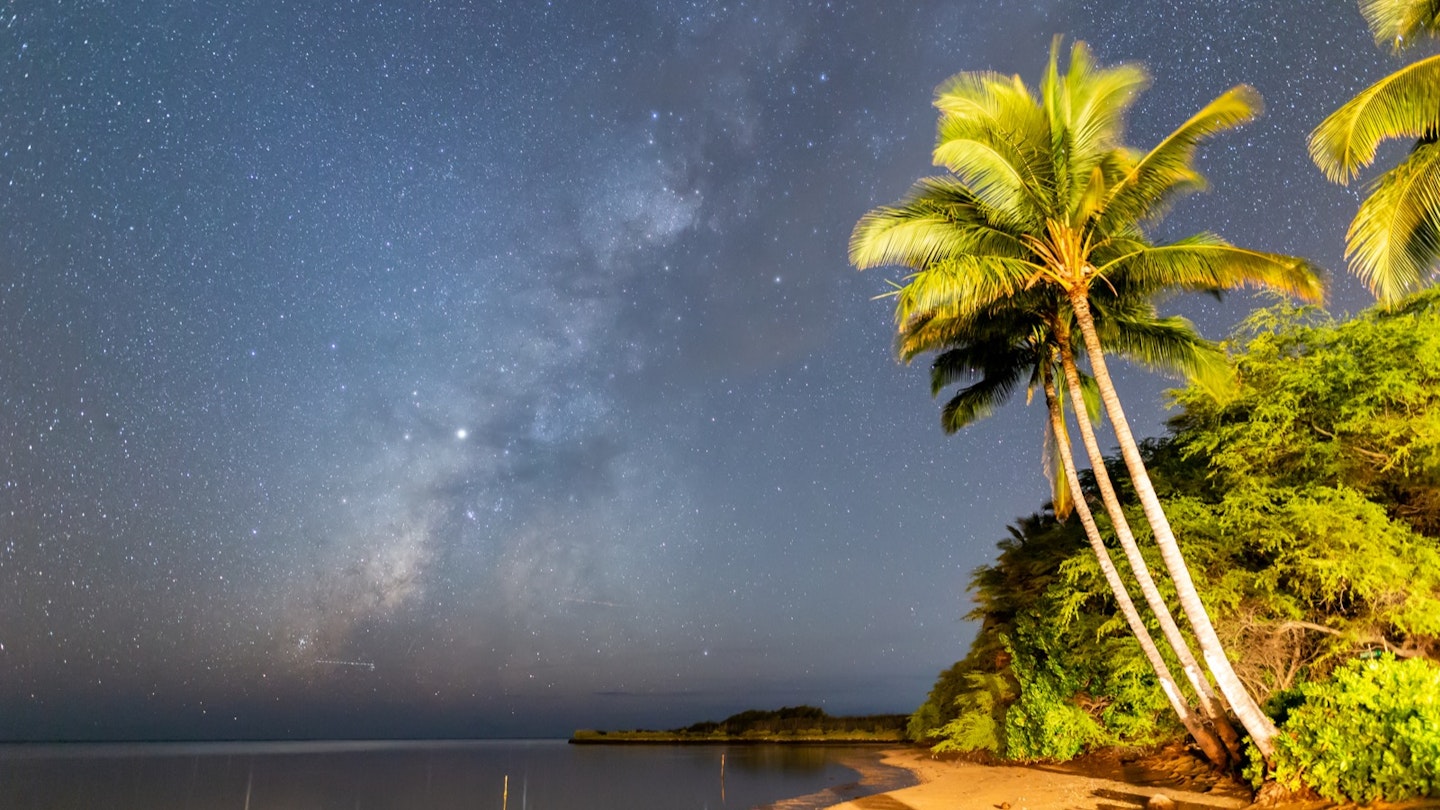Few places in Hawaii are as untouched as the sibling islands of Moloka’i and Lana’i. Rare are the high-rises, shopping centers, and crowded beaches of the other islands. Instead, visitors can immerse themselves in the tales of the islands’ past.
A visit to either of these islands is a step into Hawaii’s history, whether it’s listening to tales of a monumental tsunami that changed a valley forever, descending into a land of exiles, or learning about the rich traditions of the islands’ cowboy culture.
Hike into an Ancient Valley
The sound from Greg Solatorio’s conch shell resonates through the emerald valley, while in the distance, dogs bark in response. Traditionally, this sound announced the arrival of guests. ‘This is our “shell phone,”’ he says.
Greg serves as my guide on a hike through the Halawa Valley, a picturesque area located on the eastern side of Moloka’i. At the end of the valley lies a stunning 250-foot, double-tiered waterfall with a swimmable pool below—this is the primary reason for the hike. However, it also offers an opportunity to meet Greg, who, dressed in a red kikepa draped over his body like a toga, possesses a treasure trove of knowledge regarding Hawaiian history and culture.
Greg’s family owns the land in the Halawa Valley, and visitors can only enter with their permission. He mentions that his family has lived in the valley for generations, adhering to the practices of their ancestors—hunting for food and farming poi, a starchy root vegetable better known as taro. ‘I live self-sufficiently because it was the way of my people,’ Greg shares. ‘This is who I am.’
Journey Through Tragic History
The valley was rich enough to support a village of 5,000 people until it was devastated by a tsunami on April 1, 1946, as Greg explains. His father, Anakala Pilipo Solatorio, was just six years old at the time and recounted the story to Greg. The night before, a phone call warned of the tsunami, but the valley’s inhabitants, who only spoke Hawaiian, didn’t understand the term. ‘They thought someone named “tsunami” was arriving tomorrow,’ Greg recalls.
The following day, the waves surged over a mile into the valley, uprooting taro farms and demolishing homes. Villagers fled to higher ground, and everyone survived; however, their way of life was swept away by the tsunami’s strong force. After this catastrophe, almost all families left the valley.
Today, it remains a tranquil area of dense jungle, far removed from the high-rises in Waikiki or the landscaped resorts on Maui. Despite this, it’s rich with history and cultural significance, largely due to Greg and his family’s continued dedication to preserving traditions.
A Beautiful Prison in Kalaupapa
At the Kalaupapa Overlook, I peer over a wire fence. In the distance, 1,600 feet below, the village of Kalaupapa resembles any other small Hawaiian town: a cluster of tiny buildings encircled by green forest and frothy coastline. A white church stands at the town’s center, accompanied by a lighthouse and airport about a mile and a half away.
However, this quaint view belies the painful fact that Kalaupapa was a land of exiles for nearly a century. When the first Europeans arrived in Hawaii, they unwittingly introduced diseases that devastated the native population. Symptoms of this disaster echo throughout history, as Clare Mawae explains. She is my guide into Kalaupapa, now a national park, and shares the area’s history as we navigate a rocky path.
In 1865, the king signed a law banishing all leprosy victims to this isolated part of Moloka’i. Enclosed by some of the tallest sea cliffs globally, the Kalaupapa peninsula was chosen for its seclusion, as it still lacks direct road access to the rest of the island. The only way into Kalaupapa by land is a challenging three-mile mule trail.
The Layers of Lana’i
On the nearby island of Lana’i, I check into the Four Seasons— the sole hotel currently operating. Vast open doorways frame the resort’s private beach and beautifully landscaped pool area. The luxurious construction is part of Lana’i’s complex history, having been a protectorate of nearby Maui, a Mormon colony, a gigantic ranch, and the world’s largest pineapple plantation. In 2012, tech billionaire Larry Ellison acquired 98% of the island, beginning its evolution into a luxury travel destination, highlighted by the Four Seasons.
After settling in, I head to the Stables at Koele, which offers horseback riding tours through the pine-covered hills that form Lana’i’s heart. There, I meet Grace Fritz, a mainlander from Kansas donned in a western hat and plaid shirt, along with my horse, Zip, a cinnamon-colored mare who observes me curiously.
Conclusion
As advancements in medicine ultimately led to a cure for leprosy, mandatory isolation ended in 1969, allowing patients to leave. Yet, a handful chose to stay, including several residents who remain on the peninsula. The cliffs continue to guard the eastern coastline like tall sentinels, marking a beautiful view that is not a prison but a cherished home.





